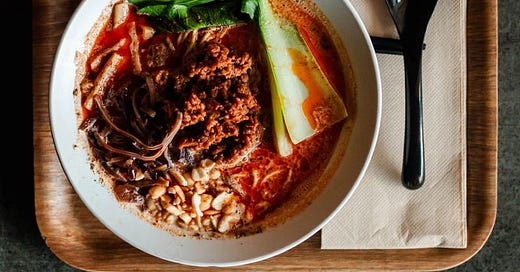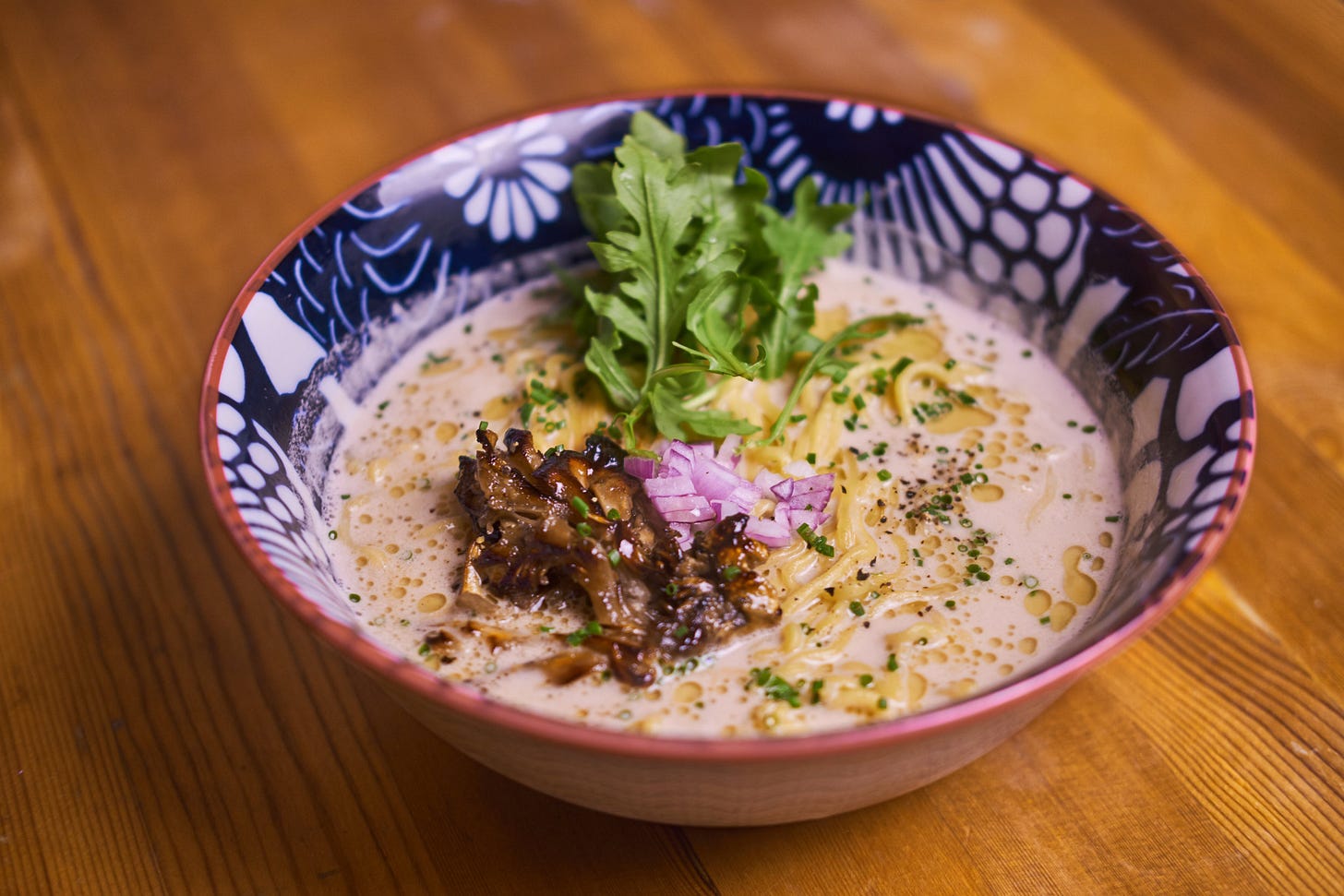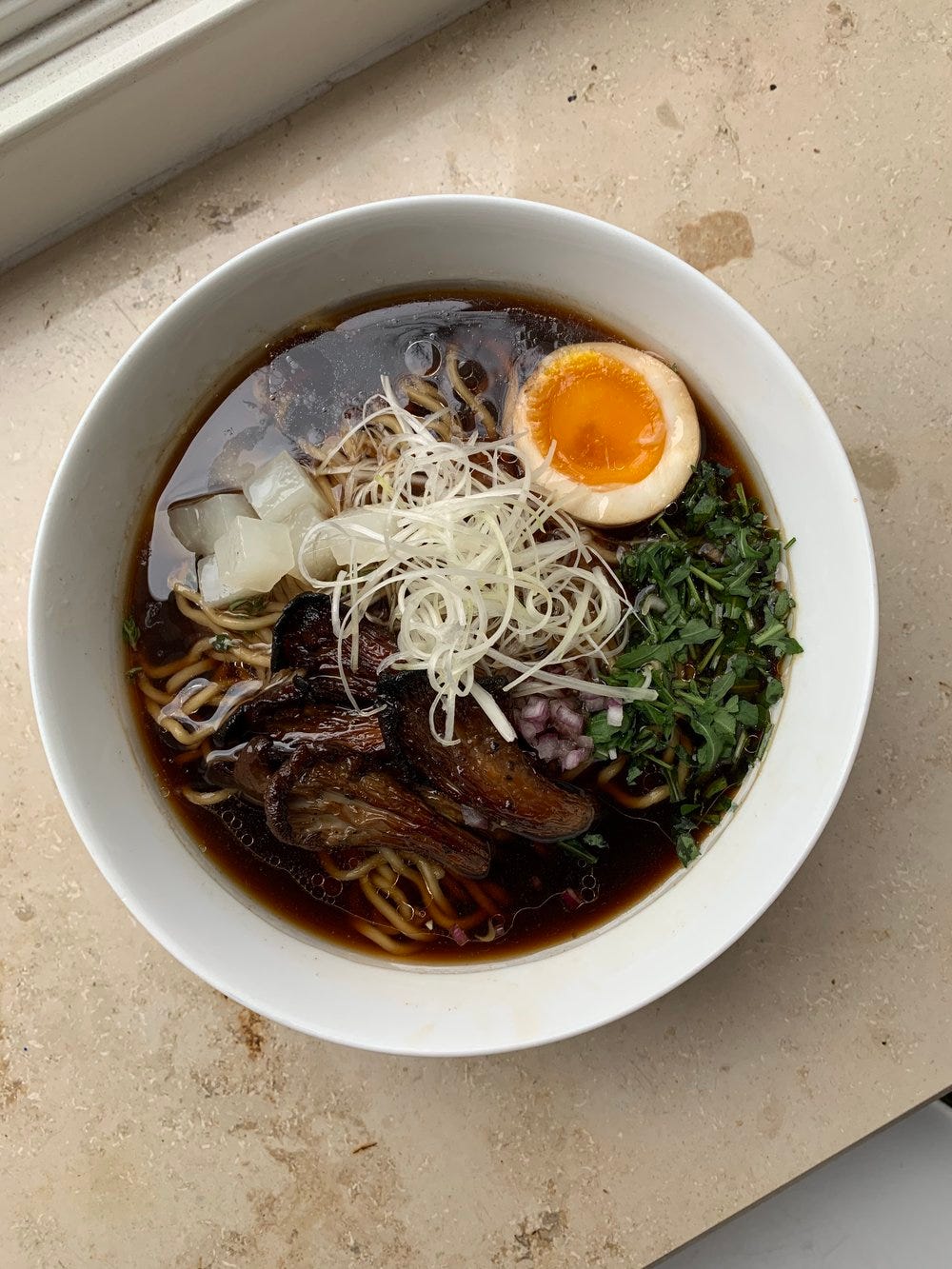Ramen 101: Vegan Ramen Broth
Thoughts, Notes and Ideas on the above... quite longwinded, but also quite a comprehensive read.
Here we go. I am back at it again; this time tackling the ever-growing world of vegan ramen (which if you don’t know, has become my thing). Instead of presenting a big long read about everything I do, I wanted to use this space primarily to look at what others have done and how it’s inspired my own craft. See this post as a somewhat sporadic mood board to fuel vegan ramen creation.
First things first, let’s address the elephant in the room. Vegan ramen is a bit of an oxymoron right? The dish has its roots in Chinese soup noodles crafted primarily with meat and fish based broths, and that’s kind of what ramen is to most of Japan, alkaline noodles served in meat-forward broths, with the addition of seafood elements commonly there to boost the umami levels of a soup. And that’s pretty much it, if you were expecting me to give you a full 180 on the topic and reveal some hidden secret that would suggest otherwise then you’d be mistaken. Vegan ramen has simply arisen to hit the dietary needs of a modern market, and for that I’m grateful.
My first soupy noodle experience was probably close to 15 years ago, and would’ve seen me taking down a bowl of meaty broth accompanied by pale noodles and thin slices of beef on top. I must’ve been around 8 or 9 years old, and this was at the time a rare indulgence whilst dining in the food court of Bristol’s infamous Galleries shopping centre. Even at the age of 26, I can still vividly mark this as my first proto-ramen experience. Several years and a trip to India later, I find myself going veggie after 3 months of university, and after a year of cheese and egg extravagance, I moved on to the cult-like extremity of veganism, or at least that’s how most people around me would’ve viewed it at the time.
So where am I going with this? Well, the short explanation is that veganism had me feeling like something was missing; this of course being the intense umami that I struggled to get whilst cooking curries, or eating a diet of falafel and Linda McCartney sausages (No MSG has been harmed in the making of LM products… unfortunately). Eventually I realised that Japanese cuisine held the secret, and I inevitably found myself falling down the savoury rabbit hole that would go on to curse my bank account and my sodium intake.
What follows within this post is a few standout examples, or ideas borrowed from a range of global ramen shops/outlets that I feel are doing some pretty cool stuff. You’ll also find me using the word “tare” a bit; this refers to the base seasoning paste/liquid that goes in to the bowl to provide salinity and umami. The tare is responsible for the categorisation of ramen in forms as: Shoyu (Soy Sauce), Shio (Salt) and Miso (Ummmm… we all know what miso is right?). Not that we are purely limited by these 3, but that’s a conversation for another day.
Anyway, let’s dive in.
SEEDY BROTH ACTION:
Base: Vegetable Stock & ‘Sunflower + Hemp Seed Paste’ (RaRa Ramen, Sydney)
“The secret to their plant-based “tonkotsu” is roasted sunflower seeds and hemp seeds. The oven’s heat unlocks the aroma, and then they grind them down into a paste, mix with light vegetable stock and strain so that it’s silky smooth but retains the creamy mouthfeel.”
Source: https://www.timeout.com/sydney/restaurants/lonely-mouth
Process Breakdown:
Roast sunflower and hemp seeds. Blend in to a smooth paste.
Mix with vegetable stock to form a milky base. Strain well to remove any lumps, and achieve a smooth but creamy stock.
Season with tare of choice.
I’ve long been a fan of the Australian ramen scene, and have ‘nerded’ over RaRa’s Instagram reels in which they dissect a few of the overall components that make their way in to each bowl. Messaging the team directly via Instagram, asking about details regarding how they do this practically (to stop the mixture splitting), this is the response received:
“With all broths that have an element of emulsion, we find it best to bring to desired heat to order. With our Tonkotsu and more stable broths, we will have a large pot simmering no hotter than 60-70 degrees, and have a smaller service pot that we fill from the larger one where we bring it to 80. The hempseed and sunflower is less stable; so we have small portions on lower heat and bring to 80 when an order comes in. You can always use a stick blender as well to re-emulsify.”
This dual pot heating setup is common in the world of Ramen (I have made use of this setup on multiple occasions) and allows you to have a large quantity of stock heating up, but avoiding any aggressively high temperatures that may result in serious evaporation.
The addition of sunflower seeds to create a luscious creamy broth has also been adopted by LA favourite Ramen Hood.
Base: Kombu & Shiitake Dashi, Miso & Sunflower Seeds (Ramen Hood, LA)
“Our broth is made by simmering kelp and shiitake mushrooms to extract their maximum umami. Then we roast sunflower seeds with white miso and combine that mixture with the kelp/mushroom stock. Then it is all pressure cooked to release the natural oils and starches from the seeds. What's left is a rich, creamy, broth that rivals it's non-vegan counterparts flavor and texture.”
Source: https://ramenhood.com/about
Process Breakdown:
Roast sunflower seeds along with miso.
Make a dashi of kombu and dried shiitake.
Combine and blend the seed/miso mixture with the dashi. You want a very smooth and creamy broth. Pass through a nut milk bag or fine strainer if required.
Their approach still feels a little mysterious; giving my experience in this field, I would assume they are probably operating with the above creamy miso soup as a universal stock and then stacking various bowls with garlic or chilli forward pastes to offer up variations upon their original creation. As to how they haven’t ended up with a complete split broth situation, I am going to guess that critical temperature control is their ‘get out of jail free’ card to avoid losing stock across long services.
NUTS AND MUSHROOMS… NUT MILK BAG, NOT OTIONAL:
This section takes a look in to how we can achieve a desired through the addition of nuts, and their milky forms to give a broth that richness and creamy texture. For this, we turn to two legends of the ‘American Indie Home Ramen Chef’ community: Preston Landers and David Chan.
Base: Mushroom Juice, Soy Milk & Hazelnut Milk (Preston Landers’ Vegan Ramen)
Process Breakdown:
Cook washed fresh mushrooms at a very low temperature (covered, to trap steam); extracting their juice to create a concentrated mushroom juice. Blend residual mushrooms and squeeze pulp through a nut milk bag to further extract flavour.
Combine juice with equal weight of water, and 20% weight in soy milk. Simmer mix with kombu seaweed and aromatics of choice.
Blend with soaked nuts (hazelnuts in the above case) before straining again through a nut milk bag.
Add and blend xanthan gum (Stabiliser) at a rate of 0.1% of the broth’s total weight. Doing so helps to prevent the broth from splitting.
Season with a Shio Koji tare.
Base: Mushroom Stock & Cashew Milk (David Chan’s Mushroom Paitan)
Process Breakdown:
Make a strong mushroom stock using fresh and dried mushrooms, kombu, aromatics and vegetables.
Soak nuts (cashews in the above case) in water at a ratio of 1:9; add a small amount of kombu to add extra umami. Soak overnight, remove kombu and blend the nuts with the remaining liquid. Strain through nut milk bag if required (I usually do).
Combine this savoury ‘nut milk’ with the stock at a ratio between 1:2/1:3 milk:stock (Applying Preston’s 0.1% XG trick wouldn’t go a miss in this application).
Sometimes, I’ll bypass the kombu cashew milk and simply soak cashews overnight, drain and blend with my standard ramen stock. I’ll admit that I am yet to be able to get it smooth enough to the level in which it doesn’t require straining through the nut milk bag, but likely put that down to not having a hyper-powerful blender within my arsenal. As with all of the above seed or nut based stocks, I advise careful temperature control when heating the stock for service. Whilst xanthan gum lends a hand, I tend to find it’s best to take the advice of the RaRa team, and hold your stock at a low temperature before heating to around 80c (90c if possible) for service.
STARCHY THINGS + UMAMI-Y THINGS:
Momofuku (of David Chang fame) in New York has a rather interesting approach to their vegan ramen broth. It follows a similar method to that of Ramen Hood in LA; in this case, the cashew creaminess is replaced through gram/besan flour. The base at Momofuku is a kombu/shiitake dashi combined with a ‘roasted’ miso paste, before a starchy slurry of chickpea flour and Yondu (Korean Vegetable Seasoning) is added to thicken and enhance (flavour-wise) the broth. Luckily for us simple folk, food writer and chef Max La Manna put together a little video going over their process (attached below).
Process Breakdown:
Make a strong dashi using dried shiitake and lots of kombu.
Add roasted miso paste (???) and whisk well until combined and creamy.
Create a slurry made of chickpea flour and Yondu seasoning. Slowly pour this in to your broth whilst whisking to combine. Heat gently to cook out the chickpea flour and lightly thicken the broth. The chickpea flour conveniently also helps to stabilise the miso within the broth.
If you were to ask me what they mean by ‘roasted miso paste’ in this case, I’d probably go out on a limb and say they’re probably combining a few different blends of miso pastes and heating them all in a pot to introduce some caramelisation and toastier notes.
FOOD TECHNIQUE BERLIN/SLURP/MENSHO APPROACH:
Slurp Ramen Joint of Copenhagen has earned a reputation as Europe’s mecca for Ramen, and rightfully so. The team are known for producing high quality bowls using a blend of Danish and Japanese produce to create premium products. Just look at the below picture of an early version of their famous veggie ramen (vegan without the egg).
At the base of their ramen is a stock built on celeriac, kombu and a blend of mushrooms. Conveniently, we live in the digital age and the Danish are quite friendly; so when I sent them a message to ask what kind of shrooms went in to the stock, they kindly told me the combo. In this case, we’re looking at a mix of shiitake, black trumpet, chanterelles, champignon and oyster mushrooms. Pretty reassuring as I’m also using a similar blend for all my Ikiko Ramen (@ikikoramen) stocks. It’s a little harder to break down the process on this one as frankly, these lot have given little away that may hint at their method for this veggie stock.
Germany’s ‘Food Technique Berlin’ (AKA Christopher Selig) offers a little more insight in to his process; with various Instagram posts revealing how he constructs his vegan broth. In this case, Christopher is building a double soup made from a rich dashi and a celeriac stock. The dashi is built around kombu, shiitake, ceps (porcini) and what he describes as “true morels”. For the dashi, Christopher soaks the seaweed and mushrooms overnight before gently bringing the mix to a simmer; removing the kombu once the temperature reaches 80c. This liquid (and mushrooms) is then combined with roasted celeriac, button mushrooms, broccoli and onion (roast thin slices at 140c for 3-4 hours or until dark), and allowed to simmer for 2-3 hours.
Whilst I said I’d focus on just the stock, whilst here, I thought I’d briefly hint at Christopher’s tare approach. In this case, he’s using a blend of 3 different shoyu (soy sauces), mirin, tamari, dried mushrooms, kombu and a small amount of sugar. Christopher notes that he adds the leftover morels in to the tare to increase the umami profile. As with any great bowl of Shoyu Ramen, a standout selection of soy sauce is key for developing that greater level of depth and flavour.
The Mensho group take a similar approach to the above, in this case building a dashi around kombu, shiitake and porcini. The stock is the enriched using vegetable scraps that would otherwise be thrown away. Quoting Ramen Beast (Abram Plaut (Mensho Tokyo SF Co-Founder)), “the soup that goes into the vegan tantanmen is made from the vegetable scraps of the prior day’s toppings. When the chefs prep the toppings each day (kale, cabbage, green onions, etc.), they save the unusable stuff such as the stems, stalks, roots or off-sized bits for the next batch of soup. This cuts down on both ingredient costs and compost garbage”. A few extra scrolls online to look at the menus inform you of the presence of the remaining components.
You can expect a breakdown of my own approach over the coming weeks.














The Vegetable Stock & ‘Sunflower + Hemp Seed Paste’ sounds very similar to a sunflower seed broth that Joe Yonan does in "Mastering the Art of Plant-Based Cooking: Vegan Recipes, Tips, and Techniques." Though I have to say that the addition of Hemp Seeds sounds like a great touch!